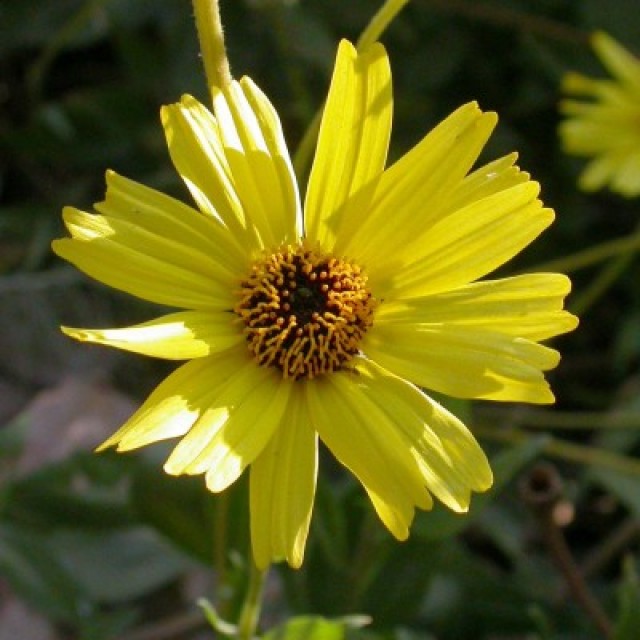COMMON NAME
California sunflower
SCIENTIFIC NAME
Encelia californica
ALSO KNOWN AS
California brittlebush
Plant family
Aster (Asteraceae)
Plant group
Broadleaf Evergreens
A broad rounded evergreen shrub with a single large yellow sunflower at the tips of branches with many slender brittle branches extending from a woody base. The diamond-shaped, silvery-green leaves are scattered along upper portions of stems. The leaves turn whitish with age. Each large yellow sunflower is actually a dense cluster of many small flowers that contains two types of flowers (ray flowers and disk flowers).
136 reports
90+
OBSERVERS
136+
OBSERVATIONS
Identification hints
Most plant species in California belong to the Aster or sunflower family. Some of these have large showy yellow flowers like the common garden sunflower (Helianthus annua) which has clusters of small disk flowers in the center and a ring of "ligulate" flowers at the edge of this disk which are attached to the bright yellow petal like structures. Unlike these herbs (which die back in the fall) Brittlebrush or California sunflower is a low, bushy, evergreen and woody plant with tall flower stems and yellow flowers with purple-brownish disks in the center. There are 5 species in the genus Encelia in California, most of which occur in dry or semi-desert habitats. California sunflower has solitary sunflowers at stem tips (rather than multiple sunflowers at stem tips, as in E. farinosa), and its disk flower corollas are brown-purplish (rather than yellow as in E.frutescens, E. actoni, and E. virginensis) and has green lance-shaped leaves (in contrast to the whitish leaves of desert species).
Did you know?
The large bright yellow sunflowers attract a variety of pollinators including bees, flies, and butterflies. Pollinators tend to stay on each sunflower for a few moments (there are many small flowers to visit on each sunflower!), providing you an opportunity to get a detailed look at their foraging behavior and physical structures. The woody stems exude a resin which was chewed and used as an exterior medicine by California tribes.
DISTRIBUTION IN TH U.S.
California
HABITAT
California Sunflower does well in direct sunlight and occupies coastal sage scrub, sandy backdune, and some interior communities. It can be found in central and southern California coastal zones, as well as in southern California’s Transverse and Peninsular Mountains in areas less than 1970 ft elevation (600 m), and in northern Baja California (Mexico).
ATTRIBUTES
Leaves
The diamond-shaped, silvery green leaves are 0.78 to 2.4 in (2 to 6 cm) long and scattered along upper portions of the stems. Petioles (leaf stems) connecting leaves to stems range in length from 0.2 to 10 in (5 to 25 mm). Leaves turn whitish with age.
Flowers
Each large yellow sunflower is actually a dense cluster of many small flowers (a head inflorescence), and each sunflower contains two types of flowers (ray flowers and disk flowers). Ray flowers, whose “ligules” extend like petals 0.6 to 1.4 in (15 to 35 mm) from the outer edge of each inflorescence number 15 to 25. They contain tiny reproductive structures at the base. Disk flowers are located on the central disk of the sunflower, have brown-purplish corollas with yellow stamens and stigma lobes extending upward about 0.2 in (5 mm) and open in concentric rings from the outer disk edge to the center. Each inflorescence is borne singly on top of a slightly hairy stalk. Flowers can bloom year-round in California but are most common April through July.
Fruits
Each ray and disk flower develops into a one-seeded fruit (an “achene”) that is about 0.23 in (6 mm) long. There is no feathery pappus for wind dispersal. Fruits and seeds typically mature during summer and autumn.
See Menu
- 2021 Chicago Botanic Garden. All Rights Reserved.
-
Creative Commons
BY-NC-SA 4.0 - Terms of Use
- Privacy Policy
- Data Sharing and Citation Policies
- 2021 Chicago Botanic Garden. All Rights Reserved.



